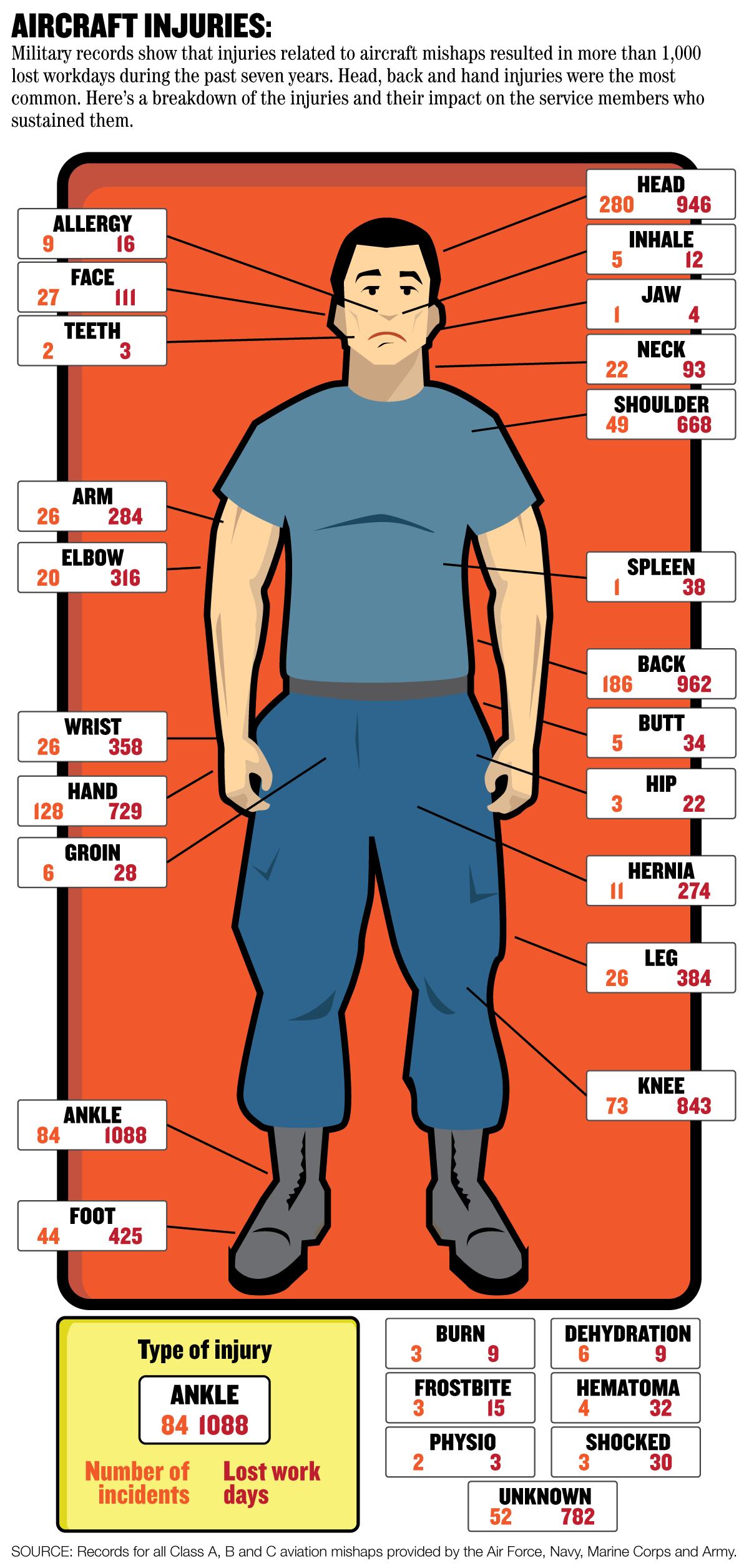It was December 2012 when an Air Force maintainer in Qatar working on a KC-135R slipped on a cargo roller nearby, fell backwards, and received a back injury and a concussion that would keep him out of work for more than three months.
It was March 2011, an airman maintaining a T-38C at Randolph AFB lost six work days to an insect bite.
And on July 2015, a service member was sitting on a C-130H tire at Joint Base Elmendorf-Richardson and somehow got stuck, leading to what the service delicately called “testicular trauma” that cost him three work days.
Bodily harm is a natural risk to working around military aircraft. The hangars where repairs and maintenance occur are filled with people scurrying around giant hunks of metal, wires and large explosives.
But at a time when the military is trying to do more with fewer people, the services lost at least 8,670 work days to aviation-related injuries between 2011 and 2017. The Military Times aviation mishap database published in April offers rare insight into the full scope of injuries across the military’s aviation community.
Click here to read more from the Aviation in Crisis project.
A few caveats are in order. The loss of work days are self-reported by the individual units, and there is not a single standard for how it is reported, so it is likely there were lost days that did not make it into the database.
And there is no standard for how much time off an injury would create ― injuries as varied as a “minor cut” and a “fractured lumbar” each led to nine lost work days, according to the data.
In addition, the figure for lost work days does not cover issues where someone was forced by an injury to sit out for a few hours, or suffered potential long-term issues. For instance, 125 concussions cost workers 466 lost work days, but given the growing understanding of how those issues can linger for years, it is likely the total of lost time is far greater. And because the data was sorted on lost work days as a standard, smaller everyday injuries that causes lost work time but not a full day off were excluded.
Overall, however, the data — sorted by injury by Defense News and Military Times — shows how the military’s aircraft maintenance corps, which is frequently described as overworked, has found itself repeatedly understaffed thanks to the human wear-and-tear of working in, on and around planes and rotorcraft.

The walking wounded
The kinds of injuries are wide and varied, but the vast majority are the kind one would expect — casual accidents occurred while maintaining aircraft.
Perhaps no adversary has done more damage to aircraft maintainers in recent years than ladders, which accounted for 82 injuries and 682 days lost.
Injuries caused by cables and wiring — being stepped on by maintainers or twisting body parts around — were reported 20 times and cost 279 work days, as well as a thumb injury so bad the maintainer had to go on permanent partial disability.
And the maintainers needs to remember to look out for antennae — the 22 times maintainers bumped into them while walking around a plane cost 51 work days. There were four incidents which cost more than 100 days of lost work. A worker tore a rotator cuff while loading a missile on an F-15C, costing 180-plus lost work days; a left ankle injury cost 180-plus days disabled for another airman working on a C-5. A maintainer for a B-1B fell off the aircraft wing, multiple injuries kept him out for 128-plus days; and an airman loading up a C-17A twisted their leg and cracked their tibia “just below knee joint,” costing 100 days off.
Seven incidents were so bad they caused maintainers to go on permanent partial disability, meaning a permanent injury occurred to the worker. Among those: an “inadvertent M-4 discharge” into the left knee of a maintainer working on a MV-22B; a severed thumb from a KC-135R landing gear; and a series of unspecified injuries to a maintainer working on the drogue system for the E-4B, the so-called “Doomsday Plane” flown by the U.S. Secretary of Defense.
In terms of body parts, make sure to keep your head on a swivel ― or maybe just pack an extra helmet. Almost a quarter of the injuries in the database involve the head, face or neck. 215 incidents occurred to the back or torso; another 230 impacted the legs, ankles, feet and toes; and another 188 impacted arms, wrists and fingers.
More rare, but still notable, injuries include three cases of frostbite while working outside on planes; three maintainers were shocked ― including one who lost 26 work days due to “neurological complications” with the incident ―and one ruptured spleen following a call from a T-38C, which cost a worker at Edwards AFB 36 work days in recovery.
And tragically, a KC-135R maintainer fell off a ladder in 2011 and lost a single work day for a “bruised buttocks.” Our best wishes for a speedy recovery.
Aaron Mehta was deputy editor and senior Pentagon correspondent for Defense News, covering policy, strategy and acquisition at the highest levels of the Defense Department and its international partners.




